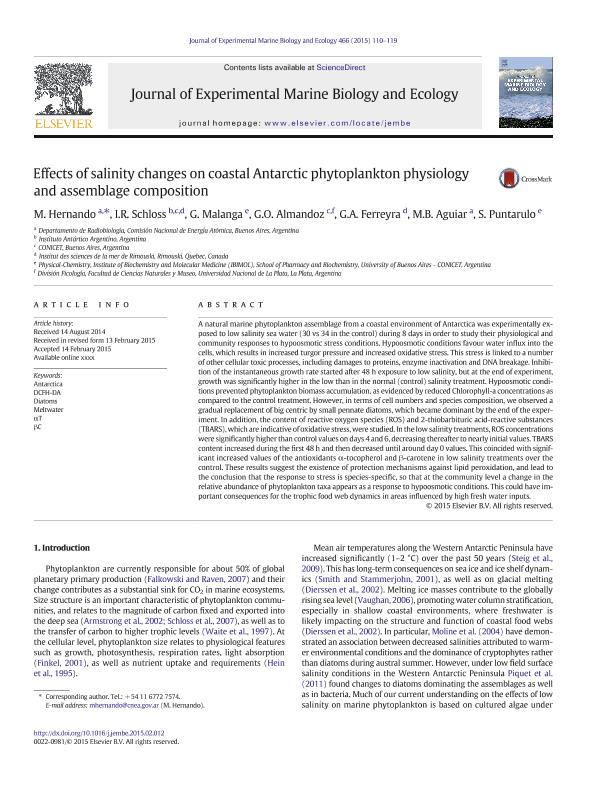Artículo
Effects of salinity changes on coastal Antarctic phytoplankton physiology and assemblage composition
Hernando, Marcelo Pablo ; Schloss, Irene Ruth
; Schloss, Irene Ruth ; Malanga, Gabriela Fabiana
; Malanga, Gabriela Fabiana ; Almandoz, Gaston Osvaldo
; Almandoz, Gaston Osvaldo ; Ferreyra, Gustavo Adolfo
; Ferreyra, Gustavo Adolfo ; Aguiar, María Belén
; Aguiar, María Belén ; Puntarulo, Susana Ángela
; Puntarulo, Susana Ángela
 ; Schloss, Irene Ruth
; Schloss, Irene Ruth ; Malanga, Gabriela Fabiana
; Malanga, Gabriela Fabiana ; Almandoz, Gaston Osvaldo
; Almandoz, Gaston Osvaldo ; Ferreyra, Gustavo Adolfo
; Ferreyra, Gustavo Adolfo ; Aguiar, María Belén
; Aguiar, María Belén ; Puntarulo, Susana Ángela
; Puntarulo, Susana Ángela
Fecha de publicación:
05/2015
Editorial:
Elsevier Science
Revista:
Journal of Experimental Marine Biology and Ecology
ISSN:
0022-0981
Idioma:
Inglés
Tipo de recurso:
Artículo publicado
Clasificación temática:
Resumen
A natural marine phytoplankton assemblage from a coastal environment of Antarctica was experimentally exposed to low salinity sea water (30 vs 34 in the control) during 8. days in order to study their physiological and community responses to hypoosmotic stress conditions. Hypoosmotic conditions favour water influx into the cells, which results in increased turgor pressure and increased oxidative stress. This stress is linked to a number of other cellular toxic processes, including damages to proteins, enzyme inactivation and DNA breakage. Inhibition of the instantaneous growth rate started after 48. h exposure to low salinity, but at the end of experiment, growth was significantly higher in the low than in the normal (control) salinity treatment. Hypoosmotic conditions prevented phytoplankton biomass accumulation, as evidenced by reduced Chlorophyll-a concentrations as compared to the control treatment. However, in terms of cell numbers and species composition, we observed a gradual replacement of big centric by small pennate diatoms, which became dominant by the end of the experiment. In addition, the content of reactive oxygen species (ROS) and 2-thiobarbituric acid-reactive substances (TBARS), which are indicative of oxidative stress, were studied. In the low salinity treatments, ROS concentrations were significantly higher than control values on days 4 and 6, decreasing thereafter to nearly initial values. TBARS content increased during the first 48. h and then decreased until around day 0 values. This coincided with significant increased values of the antioxidants α-tocopherol and β-carotene in low salinity treatments over the control. These results suggest the existence of protection mechanisms against lipid peroxidation, and lead to the conclusion that the response to stress is species-specific, so that at the community level a change in the relative abundance of phytoplankton taxa appears as a response to hypoosmotic conditions. This could have important consequences for the trophic food web dynamics in areas influenced by high fresh water inputs.
Palabras clave:
Antarctica
,
Dcfh-Da
,
Diatoms
,
Meltwater
,
Αt
,
Βc
Archivos asociados
Licencia
Identificadores
Colecciones
Articulos(CCT - LA PLATA)
Articulos de CTRO.CIENTIFICO TECNOL.CONICET - LA PLATA
Articulos de CTRO.CIENTIFICO TECNOL.CONICET - LA PLATA
Articulos(IBIMOL)
Articulos de INSTITUTO DE BIOQUIMICA Y MEDICINA MOLECULAR
Articulos de INSTITUTO DE BIOQUIMICA Y MEDICINA MOLECULAR
Citación
Hernando, Marcelo Pablo; Schloss, Irene Ruth; Malanga, Gabriela Fabiana; Almandoz, Gaston Osvaldo; Ferreyra, Gustavo Adolfo; et al.; Effects of salinity changes on coastal Antarctic phytoplankton physiology and assemblage composition; Elsevier Science; Journal of Experimental Marine Biology and Ecology; 466; 5-2015; 110-119
Compartir
Altmétricas



